
ISSN:1692-7273 | eISSN:2145-4507



Cognitive Model of a Semi-Mechanized Picking Operation
Modelo cognitivo de una operación de recolección semi-mecanizada
Modelo cognitivo de uma operação de colheita semimecanizada
Martha Caro, Leonardo Quintana, Juan A. Castillo M., Christian Zea
Cognitive Model of a Semi-Mechanized Picking Operation
Revista Ciencias de la Salud, vol. 16, 2018
Universidad del Rosario
Martha Caro * mpcaro@javeriana.edu.co
Pontificia Universidad Javeriana, Colombia
Leonardo Quintana **
Pontificia Universidad Javeriana, Colombia
Juan A. Castillo M. *** juan.castillom@urosario.edu
Del Rosario University, Colombia
Christian Zea ****
Pontificia Universidad Javeriana, Colombia
Received: 12 October 2017
Accepted: 05 February 2018
Additional information
To
cite this article: Caro M, Quintana L, Castillo JA, Zea
Ch. Cognitive Model of a Semi-Mechanized Picking
Operation. Rev Cienc Salud. 2018; 16(especial): p. 39-51. Doi: https://doi.org/10.12804/revistas.urosario.edu.co/revsalud/a.6841
Abstract: Introduction: The current paper develops a pioneering approach to the human factors of picking operations, which are addressed from a cognitive perspective. Materials and methods: The model thus contributed is established through a qualitative methodology which, based on several theories, is articulated and applied to the real situation of a dry foods company’s semi mechanized picking operation. Results: The results combine the cognitive architecture of the operation and its relations with logistic factors, in order to decrease human error and, therefore, increase service level. Conclusion: the current model provides elements for quantitative modeling, which could include this type of factors in order to optimize the picking operation of a supply chain.
Keywords: cognitive systems, human factors, human error, ergonomics, picking operation, qualitative analysis.
Resumen: Introducción: este documento desarrolla un enfoque pionero sobre los factores humanos de las operaciones semi mecanizadas de selección, las cuales se abordan desde una perspectiva cognitiva. Materiales y métodos: el modelo aportado establece a través de una metodología cualitativa y a partir de varias teorías, es articulado y aplicado a la situación real de una operación de selección (picking semi) mecanizada de una empresa de alimentos secos. Resultados: los resultados combinan la arquitectura cognitiva de la operación y sus relaciones con factores logísticos, para disminuir el error humano y, por lo tanto, aumentar el nivel de servicio. Conclusión: el modelo actual proporciona elementos para el modelado cuantitativo, el cual incluye este tipo de factores para optimizar la operación de picking de una cadena de suministro.
Palabras clave: sistemas cognitivos, factores humanos, error humano, ergonomía, operación de selección, análisis cualitativo.
Resumo: Introdução: Este documento desenvolve um enfoque pioneiro sobre os fatores humanos das operações semimecanizadas de seleção, as quais se abordam desde uma perspectiva cognitiva. Materiais e métodos: O modelo aportado estabelece através de uma metodologia qualitativa e a partir de várias teorias, é articulado e aplicado à situação real de uma operação de seleção (picking) semimecanizada de uma empresa de alimentos secos. Resultados: Os resultados combinam a arquitetura cognitiva da operação e suas relações com fatores logísticos, para diminuir o erro humano e, portanto, aumentar o nível de serviço. Conclusão: o modelo atual fornece elementos para modelagem quantitativa, que inclui este tipo de fatores para otimizar a operação de picking de uma cadeia de suprimentos.
Palavras-chave: sistemas cognitivos, fatores humanos, erro humano, ergonomia, operação de seleção, análise qualitativa.
Introduction
Cognitive ergonomics in supply chains has been studied from different points of view. For example, Resnick et al. identified training techniques such as task analysis —which is intended for improving decision making in global chains— through sophisticated metacognition (1). Specifically regarding picking operations, a study by Goomas et al. analyzed the cognitive aspects of a voice picking system, in order to improve workers’ welfare and attain better quality through error reduction (2).
These studies concluded that human factors, apart from physical aspects, should be kept in mind to achieve both welfare and better performance. According to Kanji et al. (3), human and organizational aspects should be studied by measuring individual performance in terms of percentage of errors, paying special attention to work quality. In addition, human factors have been involved in supply chain studies through mathematical optimization models (4), implying variables such as inspection or operation errors and quality learning level, which have elevated cost impacts (5, 6). However, these mathematical models have not been based on real operation conditions, but on simulations. From the perspective of information systems design (7), an experimental study for the validation of business process management (BPM) systems was undertook, so as to identify cognitive resources applied by the users to understand the software.
Furthermore, the performance of human factors within supply chains has been measured in terms of quality (i.e., error) (2, 3, 4); time (1) and even learning (4, 8).
Picking represents about 55 % of supply chain operational costs (9), since it is the most laborious and time consuming activity at a distribution center (10, 11). Picking efficiency is measured in terms of speed (12), and accuracy (whether the collected items match the picking order). In other words, picking is significant not only for the labor cost it represents, but also through the effect it has on the service level agreed with the costumer (10).
Accuracy is currently considered to be a fundamental aspect of organizational success. In labor-intense environments, accuracy has a direct relationship with picking human errors, which, in turn, are caused by storage and picking methods, among other factors (10). The picking operation, which makes use of tools such as paper list, scanner, laser and voice technology, can be carried out in different ways such as picking from multiple positions or doing multiple picks at each stop. Gu et al. say there is a direct connection between service level and picking, especially regarding picker travel speed and product search through the warehouse (13).
In turn, Grosse et al. (11) made an exhaustive literature review to identify those studies that incorporated human factors in the planning of picking operations, with the further goal of identifying those that might shelter research perspectives, by means of an adequate conceptual framework specifically developed for such purpose. In turn, worker features are considered to be determining in operation outputs (14, 15).
The conceptual framework provided by (Grosse, Glock et al. 2014) (11) identifies three macro analytical perspectives: (i) modeling and planning, which comprises layout outlining, warehouse assignment, routing and work organization. Its optimization has been studied through mathematical modeling (4, 16, 17, 18); (ii) system outputs, which cover performance, quality and worker health; and, finally, (iii) human factors, namely mental, perceptual, physical and psychosocial. For their part (Grosse, Glock et al. state that picking systems have been studied with two main goals: the improvement of effectiveness and efficiency, and the development of better conditions for workers (11). The latter contend that effectiveness and efficiency improvement are directly related to error reduction and productivity enhancement. These approaches to human factors in the picking operation allow focusing on its mental and perceptual aspects, which, in turn, constitute a new research domain featured by the encounter of cognitive elements and picking human errors.
The way the picker receives the information and makes it useful is considered to be a key perceptual aspect of the operation (11, 19). One of these perceptual aspects is the picking list, which has not been studied in distribution centers. Yet, it has been analyzed in other manual operations requiring paper picking lists, with the purpose of reducing information search time. Grosse et al. identified design, content and distribution as important aspects of the information conveyed by a picking list (11). Design is related to font size, which influences the easiness of reading and memorizing. Other aspects are color and spatial position, which have been found to affect search time (20).
Other picking system design perspectives allow for a larger influence of technology. Such is the case of radiofrequency equipment linked to warehouse management systems involving barcodes, handhelds and scanners. Likewise, it was found that a shorter item code influenced search time [20]. In turn, Weaver et al. and Brynzér et al. included graphic layout information and highlighted product amounts in the picking order list, thus reducing search time (19, 21). According to a literature review by Grosse et al. (11) and Bishu et al. (22) demonstrated that reading order in shelves works better from left to right and from top to bottom; and Gudehus et al. suggested the use of radiofrequency to facilitate information perception (23).
Picking systems are classified according to labor demand (10). Therefore, there are manual, semi mechanized and mechanized systems. About 75 % of all picking systems operate manually (10). The intense labor requirements of these dominant picking systems make human factors outstandingly important (11), all the more because they determine the effectiveness and efficiency of the process.
Making up a lower fraction (7 %), semi mechanized systems operate in three different ways: horizontal carrousel, vertical carrousel and stock picker. Among them, variations such as the “pick to pass” system have lately gained momentum as a response to electronic commerce and the need to be time-competitive. Pan et al. developed a Markov chain analysis of one of these systems to estimate picker traveling distance to the picking zone. Finally, the scarcest system type is the totally mechanized one (2 %) (18).
As to the mental aspects of picking, Grosse et al. described a relationship between an elevated proportion of repetitive tasks, cognitive picking abilities, and workload (11).
Based on the available literature on the topic, the present work has developed a cognitive model of the manual picking operation. Two steps were analyzed: information identification and the actual product picking decision. Information identification is carried out through picking lists, wherein design, content (11, 20), and distribution (19, 21), are cognitive aspects influencing speed and accuracy, as shown above.
Product picking decision has been observed to comprise two sub-steps, namely global scan and position location (24, 25). These authors studied the performance of novice and expert operators as affected by aspects like position and color. In turn, Bishu et al. conducted studies related to shelf label orientation (20). In sum, the different studies available on the cognitive elements that influence picking have been developed in different domains and, although they have been used as a reference framework for the present research, they do not allow establishing a formal cognitive model for this operation.
Nonetheless, among the most important goals of a picking system operation are its effectiveness and efficiency, which are measured by speed and accuracy, the latter being specifically related to the percentage of picking errors. Information changes and warehouse positions have been found to influence quality in terms of error percentage, likewise (19), they have detected some picking error causes: (i) mixing of several components at a given location; (ii) the operator is interrupted; and (iii) similarities in the appearance of several elements which are located close to one another. In turn, Grosse et al. found that the number of orders was inversely correlated to that of errors (26); and de Koster et al. described that a clear route pattern reduces both error and time search (12).
Finally, Brynzér et al. have described radiofrequency and barcodes as error reduction strategies. However, they do not guarantee error elimination because of the persistence of the human vs. system interaction (19). Exploratory studies on the human dimension of picking by Caro et al. had already identified a series of error types and their main causes (27).
In sum, new research avenues on the cognitive perspective have emerged with the study of human factors in picking environments such as the postal or automotive industries, resulting in conceptual frameworks that can be applied to areas that have not been addressed from such perspective. And this is precisely the case of semi mechanized picking operations in distribution centers.
Therefore, the present work actually opens a new research line through the development of a cognitive model for the real semi-mechanized picking operation of a dry foods distribution center. The model intends to identify the elements that are likely to cause human error and decrease service level.
Materials and methods
The methodology used to develop this study is based on the concepts of distributed cognitive systems (28), cognitive analysis in dynamic situations (29), and process tracing for the study of cognition outside the laboratory (30) (Woods, 1993), all of which were used to design the information collection and analysis protocol (fig. 2).
The protocol follows four phases. The first one corresponds to field observation of the natural flow of the operation by means of ethnographic techniques. This step allows identifying the characteristics of the operation and the ideal conditions for recording the task through systematic videos. At this phase, it was possible to determine the analysis unit, which corresponds to each one of the picking zones. Ten containers per picking zone were adequately labeled with information that allowed tracing the origin of the products the pickers had put in them (30). In the second phase, some videos were recorded, for them to be analyzed during the third phase through a codification system designed according to theoretical guidelines by Hoc et al. (29). This codification protocol allowed identifying cognitive architectures, which are made up of different cognitive activities and elements. In the fourth phase, a guided verbalization on the part of the operators is elicited and contrasted to video watching, seeking to confirm in depth the mental processes underlying their performance. Furthermore, at this stage it was possible to inquire into the likely error causes. In sum, the current methodology provides two main results, namely the cognitive model and the cognitive elements that might influence picking errors.
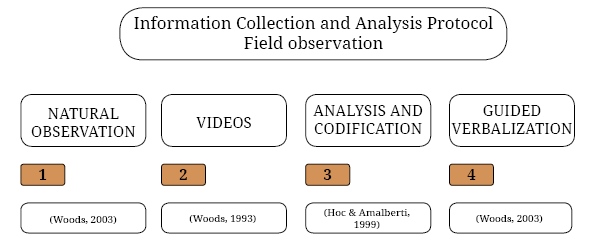
The protocol shown in figure 1 was implemented at the distribution center of one of the biggest food companies in Colombia, which makes use of a horizontal carrousel that travels around nine picking zones. Six of them store high rotation products distributed in several product families, each of which covers seven to ten meter length shelf segments. The other three picking zones contain low rotation product families occupying about ten to sixteen meter length segments each. Each picking zone is served by a logistic operator. There is a warehouse management system that uses radiofrequency to send the picking orders (i.e., information on products to be picked, amounts, codes, descriptions and availability) to the operators.
The study was carried out on a sample of 60 containers filled with approximately 622 picked products. The corresponding orders were dispatched by eight operators during two days. The error ratio observed in this sample was 3 %, which coincides with the error ratio of the whole picking operation at the time.
Results
The resulting cognitive model allows visualizing the variables of the picking operation. It is described in terms of the tasks involved in picking, as well as the information, activities and cognitive elements observed and confirmed with the operators.
The first task is reading (Table 1), which is highly focused on the identification, on the part of the operator, of the features of the products required in the order, namely shape, size, color and position. In this case, the cognitive activity is information identification (31) or detection (29). The operator establishes their mental representation (32), keeping in the operative memory the information about the requested product: name, amount and weight; and recovering from the large term memory the information related to product position and features.
The second task is searching, wherein the operator walks to where the product is placed on the shelf. In this task, the cognitive activity consists in verifying that the requested product corresponds to the one identified on the shelf. The cognitive elements involved are attention, spatial orientation and the decision to choose a product.
The third task is to actually pick the product, for which the operator uses the information stored in their operative memory (quantity and weight) and in their long-term memory (product features, amount and weight). This task consists in taking the requested product from the shelf, based on its amount, weight and size. According to the observation, it is at this point when errors are produced.
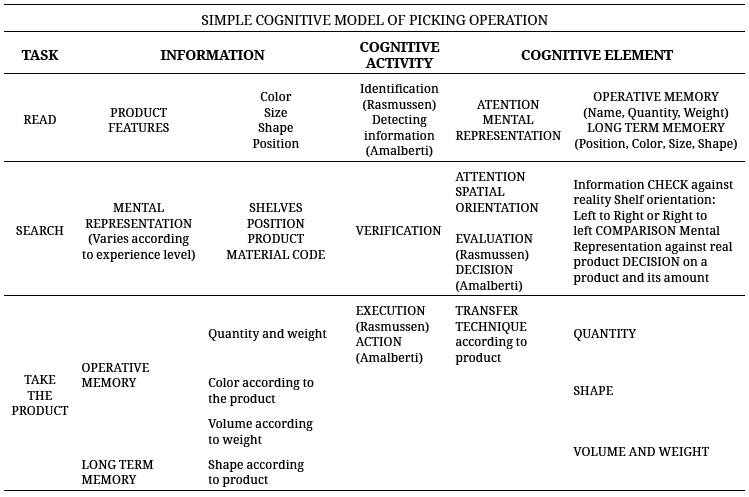
This simple cognitive model resulted from the recording, analysis and codification of the videos of the picking operation. A guided verbalization was contrasted to the analysis of 18 videos in which the errors were detected. Based on the comparison between ordered and picked amounts, figure 2 illustrates error frequency. Sixty-one percent of the errors were related to unsent products, while 39 % were associated to products sent in amounts that exceeded those specified by the corresponding orders.
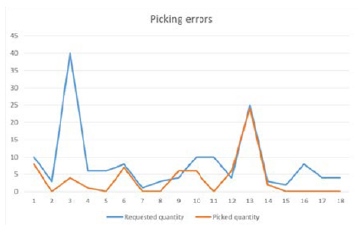
The guided verbalization was conducted through semi structured interviews in which, at first, the analyst confirmed with the operator the task described in the model. Then, they watched the videos while the analyst asked in depth about the use of information in each task. This phase allowed identifying the error causes with the collaboration of the operators (table 2). Fifty five percent of the causes were found to be directly related to memory.
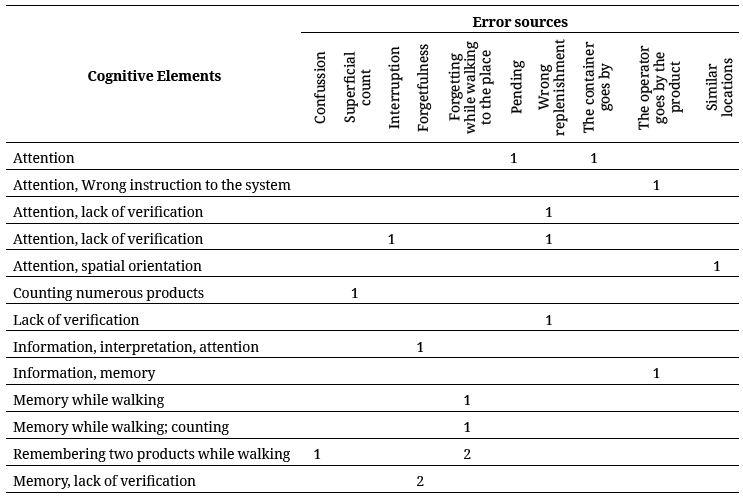
Interestingly, product search strategy differences were observed between novice and expert operators, since the latter resort to their experience and knowledge of the picking area, while novice operators use location coordinates. Hence, expert operators only need the name of the product, since the rest of the information is stored in their long-term memory.
This is evident from the answers of the operators when asked about the order in which they read and used the information during the picking operation. In effect, 60 % of the operators (actually the most experienced ones) declared using the product’s description as the informational key to start the process; while 40 % (the novices) confirmed using product location for the same purpose.
The detailed description of the use of information by the operators, which is provided by the simple cognitive model, allows observing that in the reading task both novices and experts use the same data: product description, location and code. However, they resort to different memory types, since the novice needs to read the radio frequency, while the expert already keeps these features stored in their long-term memory.
Finally, when it comes to the task of actually picking the product, there are no differences between novices and experts, since they are already in front of the shelf to take the product. For such purpose, they only use their operative memory to remember the amount and weight of the product in question. It was precisely at this point where most errors were committed, since they were related to selecting wrong amounts (more or less than requested).
Although this simple cognitive model reveals some perceptual and mental aspects of the picking operators’ performance, as well as differences between novices and experts, field observation also allowed observing relationships between them and their logistic context. The variables that account for this relation are picking zone type (high rotation, low diversity vs. low rotation, high diversity) and the combination of products to be picked, which is featured by amount, weight and size.
Picking zone types, which are related to the product search task, are featured by different product storage modes according to demand behavior. The high rotation zone is an approximately 10 meter long section where there are large amounts of a few products. This implies both that the operator does not have to walk long distances to search and pick a product, and that there are not many references to search through. In turn, the low rotation zone, which is approximately 10 to 16 meter long, stores low amounts of many different products.
Finally, the variable “combination of products to be picked” influences the actual product picking task. This is certainly a determining factor, since it is at this particular moment when the operator selects a product and decides on its amount, thus actually making a right or wrong choice. This variable is affected by three factors, namely product amount, weight and volume. The hypothesis underlying this concept is that the larger the amount of a product, the higher its weight, volume and actual picking difficulty, which, in turn, increases the probability to commit a mistake.
As it is described below, a complex cognitive model of the picking operation results from the inclusion of the additional relationships introduced above (fig. 3).
Discussion and Further Research
The complex cognitive model of the picking operation highlights the way mental and perceptual aspects can be affected by the conditions imposed by the logistic context of picking. Figure 3 shows how “experience level”, “picking zone type” and the “combination of products to be picked” are likely to influence perceptual and mental aspects such as “information employed” or “memorization mode” (storage of information in the operative or long term memory), which finally affect attention at the moment of product selection and counting.
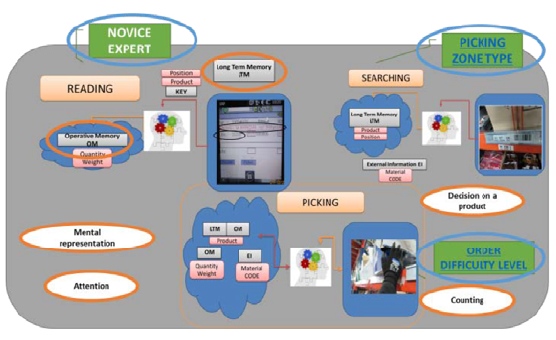
The model above constitutes a qualitative approach, which should be validated through further research in controlled scenarios, thus allowing the experimental study of the factors involved [28], in order to determine their influence on picking error.
From the current analysis it is clear that the picking operation constitutes an interaction between human factors and their logistic context, which is, e.g., the one imposed by a semi mechanized operation.
Understanding the cognitive and logistics parameters that are likely to influence human error opens new research avenues related to the design of training or information systems, among others. These systems should include said parameters as inputs, in order to improve operator performance and, therefore, the picking operation.
Furthermore, the current model provides elements for quantitative modeling, which could include this type of factors in order to optimize the picking operation of a supply chain.
This model constitutes a step forward in the study of the human factors of picking within the framework introduced by (11), where they are highly important for the quality and efficiency of the operation
Acknowledgements
The authors would like to thank Comercial Nutresa S.A.S. for their collaboration and unconditional support in the development of this project.
References
1. Resnick ML. Human Factors in Complex Systems: Global Value Chains. IIE Annu Conf. 2008;235–40.
2. Goomas DT, Yeow PH. Ergonomics Improvement in a Harsh Environment Using an Audio Feedback System. Int J Ind Ergon. 2010;40(6):767–74.
3. Arzu Akyuz G, Erman Erkan T. Supply Chain Performance Measurement: A Literature Review. Int J Prod Res. 2010;48(17):5137–55.
4. Khan M, Jaber M, Guifrida A. The Effect of Human Factors on the Performance of a Two Level Supply Chain. Int J Prod Res. 2012;50(2):517–33.
5. Raouf A, Jain J, Sathe P. A Cost-Minimization Model for Multicharacteristic Component Inspection. AIIE Trans. 1983;15(3):187–94.
6. Jaber M, Bonney M. The Lot Sizing Problem and the Learning Curve: a Review. Learning Curves, Theory, Models and Applications. CRC Press Taylor Fr Group, Boca Rat. 2011;265–91.
7. Swan BR. The Effects of Business Process Management Cognitive Resources and Individual Cognitive Differences on Outcomes of User Comprehension. 2007. Available from: http://hdl.handle.net/10919/26969
8. Zink KJ, Seibert S. Performance Measurement from a Macroergonomics Perspective. Ind Eng Ergon. 2009;91–103.
9. Tompkins JA, White JA, Bozer Y., Tanchoco JMA. Facilities Planning. John Wiley & Sons. 2010.
10. Burinskiene A. Order Picking Process at Warehouses. Int J Logist Syst Manag. 2010;6(2):162–78.
11. Grosse E., Glock CH, Jaber MY, Neumann WP. Incorporating Human Factors in Order Picking Planning Models: Framework and Research Opportunities. Int J Prod Res [Internet]. 2015;53(3):695–717. Available from: https://doi.org/10.1080/00207543.2014.919424
12. De Koster R, Le-Duc T, Roodbergen KJ. Design and Control of Warehouse Order Picking: A Literature Review. Eur J Oper Res. 2007;182(2):481–501.
13. Gu J, Goetschal CKX M, Mc Ginnis LF. Research on Warehouse Design and Performance Evaluation: A Comprehensive Review. Eur J Oper Res. 2010;203(3):539–49.
14. Powell GN, Johnson GA. An Expectancy-Equity Model of Productive System Performance. J Oper Manag. 1980;1(1):47–56.
15. Karwowski W. The Discipline of Ergonomics and Human Factors. Handb Hum factors Ergon. 2006;3.
16. Lin C, Lu I. The Procedure of Determining the Order Picking Strategies in Distribution Center. Int J Prod Econ. 1999;60:301–7.
17. Wong WP, Wong KY. Supply Chain Performance Measurement System Using DEA Modeling. Ind Manag Data Syst. 2007;107(3):361–81.
18. Pan JC, Wu M. A Study of Storage Assignment Problem for an Order Picking Line in a Pick-and-Pass Warehousing System. Comput Ind Eng. 2009;57(1):261–8.
19. Brynzér H, Johansson MI. Design and Performance of Kitting and Order Picking systems. Int J Prod Econ. 1995;41(1–3):115–25.
20. Bishu R, Donohue B, Murphy P. Cognitive ergonomics of a mail order filling Company: Part 1—Influence of Colour, Position and Highlighting on Recognition Time. Appl Ergon. 1991;22(6):367–72.
21. Weaver KA, Baumann H, Starner T, Iben H, Lawo M. An Empirical Task Analysis of Warehouse Order Picking Using Head-Mounted Displays, Proceedings of the SIGCHI. Conf Hum Factors Comput Syst 2010, ACM. 2010;1695–704.
22. Bishu RR, Donohue B, Murphy P. Cognitive Ergonomics of a Mail Order Filling Company: Part 2 - Influence of Shelf Coding and Address Information on Acquisition Time. Appl Ergon [Internet]. 1992;23(2):115–20. Available from: http://sciencedirect.com/science/journal/00036870
23. Gudehus T, Kotzab H. Comprehensive Logistics. Springer. 2009.
24. Duncan J. Selective Attention and the Organization of Visual Information. J Exp Psychol. 1984;113(4):501.
25. Julesz M. Experiments in the Visual Perception of Texture. Sci Am. 1975;232:34–43.
26. Grosse EH, Glock CH. An Experimental Investigation of Learning Effects in Order Picking Systems. J Manuf Technol Manag. 2013;24(6):850–72.
27. Caro M, Segura T, Quintana L. Human Error Before and After the Implementation of Mechanized Sorting System in Proceeding 6th International Conference on Operations and Supply Chain ManagementAt: Bali, Indonesia; 1129-41.
28. Woods DD. Discovering How Distributed Cognitive Systems Work. Handb Cogn task Des. 2003;37–53.
29. Hoc J, Amalberti R. Analyse des activités cognitives en situation dynamique: d’un cadre théorique à une méthode. Trav Hum. 1999;97–129.
30. Woods DD. Process Tracing Methods for the Study of Cognition Outside of the Experimental Psychology Laboratory. Decision Making in Action: Models and Methods. 1993;228–51.
31. Rasmussen J. Human errors. A Taxonomy for Describing Human Malfunction in Industrial Installations. J Occup Accid. 1982;4(2):311–33.
32. Ochanine, D. Le rôle des images opératives dans la régulation des activités de travail. Psychologie et Education, 1978; 3, 63-65.
Author notes
* Martha Caro, MSc
Corresponding author: mpcaro@javeriana.edu.co
** Leonardo
Quintana, PhD
*** Juan A. Castillo M., PhD
**** Christian Zea, MSc
Conflict of interest declaration
The authors
declare that they do not have any conflict of interest. This study has not
received any financial support apart from the internal resources from the
executing institution.



